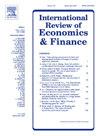The development, regional differences, and dynamic evolution of China's Green Finance in the context of “Carbon Peaking and Carbon Neutrality”
IF 4.8
2区 经济学
Q1 BUSINESS, FINANCE
引用次数: 0
Abstract
Playing a crucial role, Green Finance will realize the goals of Carbon Peaking and Carbon Neutrality. Using the entropy-weight TOPSIS method, this article will estimate the development level of China's Green Finance from 2005 to 2020. Furthermore, Dagum Gini coefficient is used to explore the overall differences, intra-region distinctions and inter-region disparities in the development of China's Green Finance to pinpoint the sources of such variations. By employing Kernel density estimation and Markov chain analysis methods, the dynamic evolution of the distribution is also explored. The findings reveal that from 2005 to 2020, the level of China's Green Finance development depicted an upward trend of fluctuation, with the average comprehensive index value standing at 0.2883, still relatively low. During the observation period, regional disparities in China's Green Finance development were prominent, characterized by a pattern that the finance development in eastern areas was stronger, while the finance development in western areas was weaker, meanwhile the central region and the western region are lower than the annual average, moreover the northeast region fluctuates greatly. The regional disparity is primarily due to the impact of high variability density, contributing an average of 42.345 %. In terms of the dynamic evolution of distribution, Chinese Green Finance development exhibits strong stability, showcasing club convergence characteristics. When considering spatial factors, China's Green Finance development level displays pronounced club convergence tendencies. Focused on national policies and aligned with the actual Green Finance distribution in China, this paper proposes methods and suggestions on how to facilitate the innovative development of Green Finance products, strengthen the internal management of financial institutions, and adopt a strategy for regional coordinated development to narrow the gap in Green Finance development levels among different regions under the background of Carbon Peaking and Carbon Neutrality, thus promoting the development of Green Finance in various regions.
求助全文
约1分钟内获得全文
求助全文
来源期刊
CiteScore
7.30
自引率
2.20%
发文量
253
期刊介绍:
The International Review of Economics & Finance (IREF) is a scholarly journal devoted to the publication of high quality theoretical and empirical articles in all areas of international economics, macroeconomics and financial economics. Contributions that facilitate the communications between the real and the financial sectors of the economy are of particular interest.

 求助内容:
求助内容: 应助结果提醒方式:
应助结果提醒方式:


